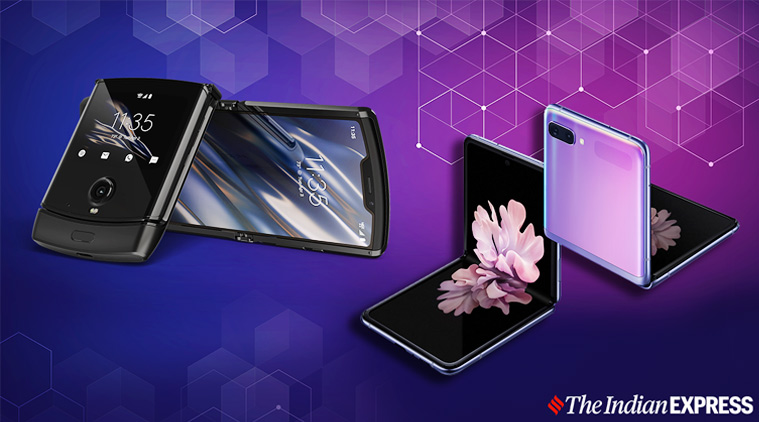 Motorola razr is now official in India, but how does it compare to the Samsung Galaxy Z Flip? Here’s an in-depth look. (Image created by Gargi Singh)
Motorola razr is now official in India, but how does it compare to the Samsung Galaxy Z Flip? Here’s an in-depth look. (Image created by Gargi Singh)
Moto razr, Motorola’s first foldable phone with the iconic clamshell design of the original Razr devices, is now available in India. But Motorola razr already has competition in the form of the Samsung Galaxy Z Flip, which was announced in India end of February and is priced lower for its sales that start this week.
The Motorola razr pre-bookings start today, both online on Flipkart and in offline retail stores. But which is the better foldable flip phone? We compared the Motorola razr and Galaxy Z Flip.
Motorola razr and Galaxy Z Flip: Price, availability
Let’s start with the price since this is the one thing you can’t afford to ignore about both these phones. The foldable form factor means yes, both the Motorola razr and the Samsung Galaxy Z Flip are expensive phones. They are offering an innovative design and the flexible display, which is the highlight of these phones, adding to the extra cost.
The Motorola razr starts at Rs 1,24,999 which makes it more expensive than the Galaxy Z Flip that costs Rs 1,09,999. Further, the Moto razr will only be made available from April 2 in offline stores and on Flipkart. The device is only open for pre-booking.
The Galaxy Z Flip is available on the Samsung official online store for India for ready purchase. Samsung also has the Galaxy Z Flip on display in some of its select offline retail stores for those who want to check out the phone before buying.
The Motorola razr is coming with some launch offers. These include Rs 10,000 cashback for Citibank Debit and Credit card users. Those using the phone on Jio will get one year of unlimited services absolutely free-of-cost, and double data benefits when recharging with Jio’s Rs 4,999 annual plan. Motorola is also offering one-time screen replacement at Rs 7,999, which will be crucial given this is a foldable display, and if someone were to break it, the repair cost will be quite high.
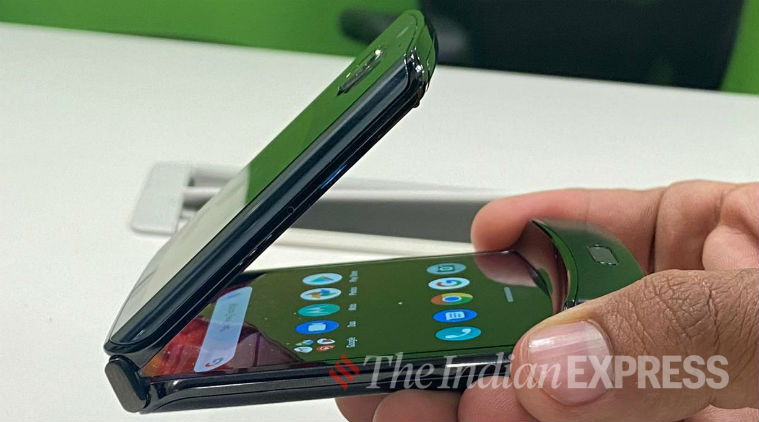 Motorola Razr comes with a plastic OLED display, which is flexible. (Image source: Anuj Bhatia/Indian Express)
Motorola Razr comes with a plastic OLED display, which is flexible. (Image source: Anuj Bhatia/Indian Express)
Samsung is also offering the Galaxy Z Flip with accidental damage coverage, and this includes one-time screen protection. The company has also set up a 24X7 dedicated Call Center Support for the phone at 1800-20-7267864. There’s also one year of Samsung Care+ Protection free, which includes one-time screen damage protection service for inner screen and external screen at discounted fee (at the time of repair). Samsung has not specified the exact amount. The Galaxy Z Flip also comes with four months of free YouTube premium subscription.
Motorola razr vs Samsung Galaxy Z Flip: Differences in design, display
Yes, both of these are ‘flip’ phones, with a flexible display, but there are key differences in Samsung and Motorola’s approach. Motorola’s display when unfolded is 6.2-inches and this is a foldable pOLED, with the company using a plastic OLED. The resolution is HD at 2142 x 876p and the screen’s aspect ratio is 21:9. The outer display of the razr is 2.7-inches gOLED with a resolution of 600 x 800p and a 4:3 aspect ratio.
DON’T MISS: We used the Motorola Razr, and here’s what we thought of it
In comparison, the Galaxy Z Flip, sports a 6.7-inch display when unfolded, which makes it bigger than the razr. The display resolution is also higher at 2636 x 1080 (FHD+) and this is a Dynamic AMOLED screen. The outer display, which is on the cover of the Z Flip is smaller at 1.1-inches with 300 x 112 resolution and this is a Super AMOLED screen. The major difference is that Samsung is using a glass display on the Z Flip, though it has an outer layer of plastic for protection.
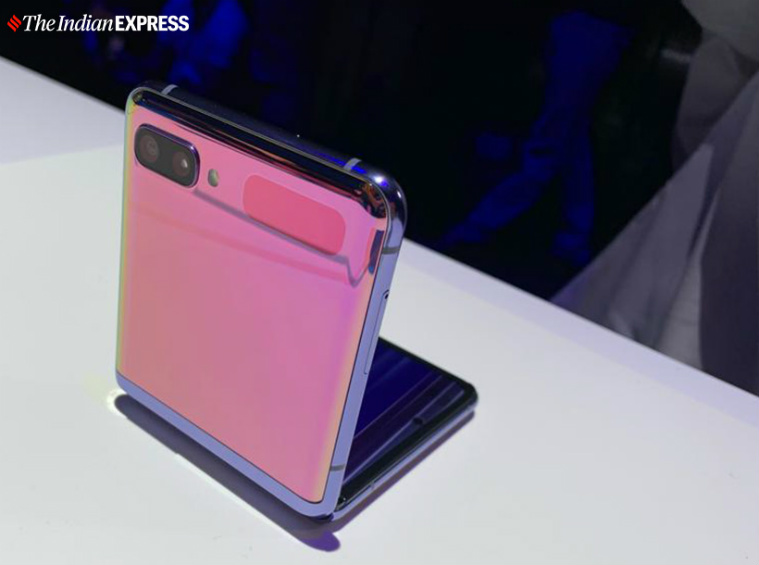 The Galaxy Z Flip comes in some bold colour choices, including this gold version. (Image source: Sneha Saha/Indian Express)
The Galaxy Z Flip comes in some bold colour choices, including this gold version. (Image source: Sneha Saha/Indian Express)
Samsung’s ultra-thin glass is being claimed as very durable because it has a shock absorption layer to deal with the impact and protect against “defects such as cracks and bubbles,” according to earlier reports. The company has protected this display with a plastic foil on top. But that does not mean the display is scratch-resistant like you would find on phones sporting Gorilla Glass on top of their screens.
With the Galaxy Z Flip, you need to still protect the screen against sharp objects, which can leave scratch marks. Given the Z Flip has a glass screen with a better resolution, it does give this an edge over the Motorola razr.
The Motorola razr comes with what the company calls as a ‘zero-gap hinge’. Motorola has patented the hinge design, which it claims prevents creasing in the foldable display when it is closed. The phone has what the company calls as “moveable metal support plates” which pull the display tight when it is opened, and when closed, these plates move out of the way to allow the display to rest in a more relaxed shape. So while the Moto razr’s display does not have a crease in the display, the Galaxy Z Flip does have a crease, which is slightly visible.
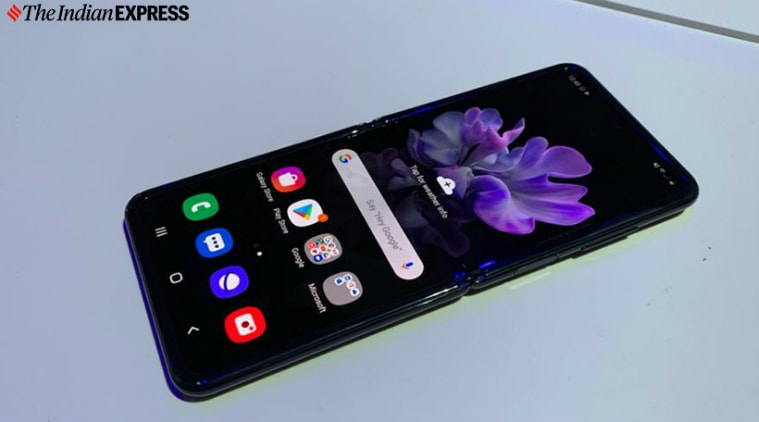 The Galaxy Z Flip’s display has a slight crease in the centre. (Image source: Sneha Saha/Indian Express)
The Galaxy Z Flip’s display has a slight crease in the centre. (Image source: Sneha Saha/Indian Express)
The Motorola razr has glass on the front, stainless steel frame and rugged plastic at the back and comes in Black Noir option, so the colour choices are limited. But it comes with some splash-proof nanocoating, which is not there on the Galaxy Z Flip. The razr is also heavier at 205 grams compared to the 183 grams weight of the Samsung phone. The Galaxy Z Flip has Gorilla Glass at the front and back and comes in slightly bolder options such as purple, black and gold, with a strong Mirror-like finish outside, which makes it looks more premium and flashy.
Motorola razr vs Samsung Galaxy Z Flip: eSIM devices
The razr is an eSIM-only device, which means you would need to ensure that your network operator supports that facility before you decide to buy it. Currently in India, Airtel and Jio offer eSIM capabilities and you will need to convert your regular SIM into an eSIM should you make this your primary phone. The Galaxy Z Flip is dual-SIM with support for a nano-SIM and an eSIM feature.
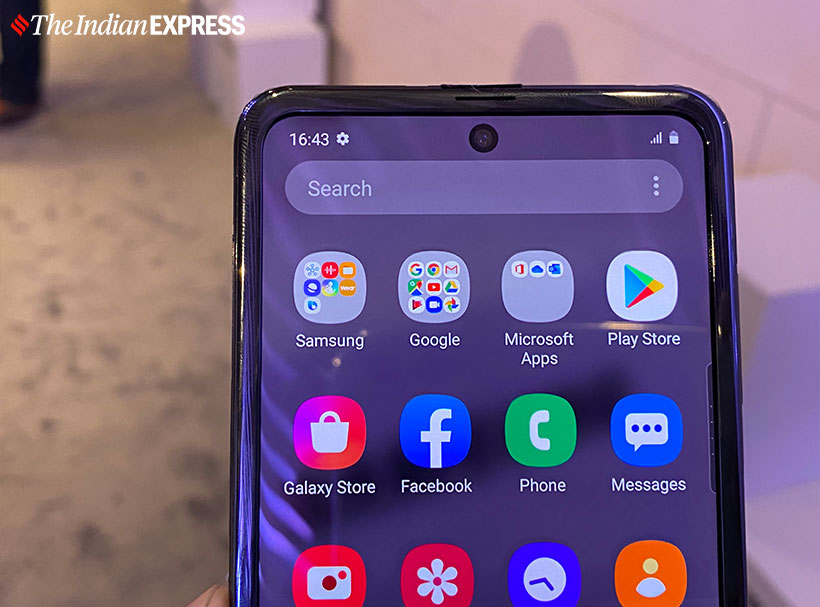 Samsung Galaxy Z Flip has a 10MP front camera, in the punch-hole format as we have seen on other flagship Samsung phones. (Image source: Anuj Bhatia/ Indian Express)
Samsung Galaxy Z Flip has a 10MP front camera, in the punch-hole format as we have seen on other flagship Samsung phones. (Image source: Anuj Bhatia/ Indian Express)
Motorola razr vs Samsung Galaxy Z Flip: Specifications
This is where the Galaxy Z Flip has a clear edge. It runs the more powerful Qualcomm Snapdragon 855+ processor and comes with the faster UFS 3.0 storage of 256GB and 8GB RAM. It also includes a side fingerprint scanner, along with support for Face Recognition. The Galaxy Z Flip has dual battery on board, which is a total of 3300 mAh, this is a combination of 930 + 2,370 mAh. There’s 15W wired charging support and it also comes with the Wireless PowerShare feature from Samsung to let users charge other compatible devices with this.
The Motorola Razr comes with the older Qualcomm Snapdragon 710 processor, which we have seen on several mid-range phones from players like Realme in India. It has 6GB RAM and 128GB storage. The battery size is smaller at 2510 mAh, though it does come with a fingerprint reader as well.
Express Tech is now on Telegram. Click here to join our channel (@expresstechie) and stay updated with the latest tech news
Motorola razr vs Samsung Galaxy Z Flip: Camera
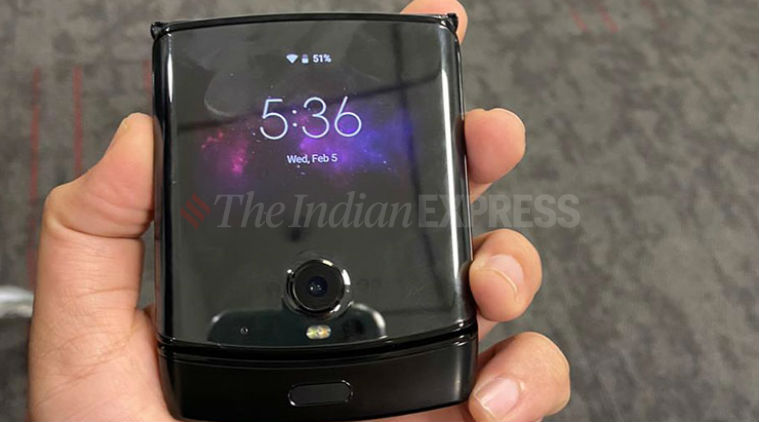 Motorola Razr when closed. The single 16MP camera then acts as a selfie camera. (Image source: Anuj Bhatia/Indian Express)
Motorola Razr when closed. The single 16MP camera then acts as a selfie camera. (Image source: Anuj Bhatia/Indian Express)
The Motorola razr gets a single 16MP camera with f/1.7 aperture, which the company says can be used for photos and selfies. The camera works as the back camera when the phone is open, and the selfie camera when the device is shut.
Motorola has added features like Night Vision mode to improve photos in low light where it combines eight frames at different exposures to ensure brighter pictures. The camera also has some AI features to recognise group shots automatically, improving the photo composition, etc.
The Galaxy Z Flip has dual rear cameras, which includes a 12MP wide-angle camera and a secondary 12MP ultrawide-angle camera. The front camera on the Z Flip is 10MP and it has the punch-hole style as seen on other Samsung flagships such as the Note 10, S20+, etc.
Motorola razr vs Samsung Galaxy Z Flip: Software
The Motorola razr might have clean stock Android, but it still runs a two-year-old version of the operating system which is Android 9 or Android Pie. The Galaxy Z Flip is on the latest version and runs Android 10 out of the box with Samsung’s One UI on top. Other features of the Z Flip include HDR 10+ for video and Dolby Atmos for audio enhancement.
The Galaxy Z Flip also has features like the Flex Mode, where the display automatically splits into two screens, to let users view images, content or videos on the top half, while the bottom can be used to control them. There’s also the option for Multi-Active Windows to let users access two separate apps on the top and bottom halves of the screen.
Now, you decide which one of the two makes more sense for you.